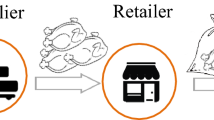Abstract
Numerous economic order quantity (EOQ) models have by and large been ascertained for assembling items. Several distinctive EOQ models have been anticipated in order to incorporate the significant features related to a particular class of items. This paper intends a model aimed at a particular class of inventory i.e. growing items. Some genuine instances of growing items are poultry and livestock. We commence by intending a wide-ranging scientific model, that might be utilized for several categories of growing items, trailed by a specific numerical model considering a certain category of chickens. The model aims to ascertain the optimum order quantity of the items to be ordered in the beginning of a cycle, the optimum length of the growing cycle and the optimum total profit of the retailer in the presence of allowable deferment in payments. Numerical examples are provided to represent the model. A sensitive study is exhibited to examine the impact of the primary factors of the model as far as it’s decision variables and objective function are considered.





Similar content being viewed by others
References
Abad, P.L., Jaggi, C.K.: A joint approach for setting unit price and the length of the credit period for a seller when end demand is price sensitive. Int. J. Prod. Econ. 83(2), 115–122 (2003)
Aggarwal, S.P., Jaggi, C.K.: Ordering policies of deteriorating items under allowable deferment in payments. J. Oper. Res. Soc. 46(5), 658–662 (1995)
Choi, D.W., Hwang, H., Koh, S.-G.: A generalized ordering and recovery policy for reusable items. Eur. J. Oper. Res. 182(2), 764–774 (2007)
Chu, P., Chung, K.J., Lan, S.P.: Economic order quantity of deteriorating items under allowable deferment in payments. Comput. Oper. Res. 25(10), 817–824 (1998)
Chung, K.J., Liao, J.J.: The optimum ordering policy in a DCF analysis for deteriorating items when trade credit depends on the order quantity. Int. J. Prod Econ. 100(1), 116–130 (2006)
Chung, K.J.: A theorem on the determination of economics order quantity under conditions of allowable deferment in payments. Comput. Oper. Res 25, 49–52 (1988)
Chung, K.J., Huang, Y.F.: Retailer’s optimum cycle times in the EOQ model with imperfect quantity and a permissible credit period. Qual. Quant. 40(1), 59–77 (2006)
Dye, C.Y., Ouyang, L.Y.: An EOQ model for perishable items under stock dependent selling rate and time dependent partial backlogging. Eur. J. Oper. Res. 163(3), 776–783 (2005)
Gharaei, A., Almehdawe, E.: Economic growing quantity. Int. J. Prod. Econ. 223, 107517 (2020)
Goyal, S.K.: Economic order quantity under conditions of allowable deferment in payments. J. Oper. Res. Soc. 36(4), 335–338 (1985)
Harris, F.W.: How many parts to make at once. Factory Mag. Manag. 10, 135–136 (1913)
Jaggi, C.K., Goel, S.K., Mittal, M.: Credit financing in economic ordering policies for imperfect quality items with allowable shortages. Appl. Math. Compu. 219(10), 5268–5282 (2013)
Koh, S.-G., Hwang, H., Sohn, K.-I., Ko, C.-S.: An optimum ordering and recovery policy for reusable items. Comput. Ind. Eng. 43(1–2), 59–73 (2002)
Mabini, M.C., Pintelon, L.M., Gelders, L.F.: EOQ type formulations for controlling repairable inventories. Int. J. Prod. Econ 28(1), 21–33 (1992)
Nahmias, S.: Perishable inventory theory: a review. Oper. Res. 30(4), 680–708 (1982)
Nobil, A.H., Sedigh, A.H.A., Cardenas-Barron, L.E.: A generalized economic order quantity inventory model with shortage: case study of a poultry farmer. Arab. J. Sci. Eng. 44, 2653–2663 (2018)
Padmanabhan, G., Vrat, P.: EOQ models for perishable items under stock dependent selling rate. Eur. J. Oper. Res 86(2), 281–292 (1995)
Rezaei, J.: Economic order quantity for growing items. Int. J. Prod. Econ. 155, 109–113 (2014)
Rezaei, J.: Economic order quantity model with backorder for imperfect quality items. In: Proceedings of the IEEE International Engineering Management Conference, 11–13 September, St. John’s, Newfoundland, Canada, pp. 466–470, (2005)
Rezaei, J., Salimi, N.: Economic order quantity and purchasing price for items with imperfect quality when inspection shifts from buyer to supplier. Int. J. Prod. Econ. 137(1), 11–18 (2012)
Richter, K.: The extended EOQ repair and waste disposal model. Int. J. Prod. Econ 45(1–3), 443–447 (1996)
Salameh, M.K., Jaber, M.Y.: Economic production quantity model for items with imperfect quality. Int. J. Prod. Econ 64(1–3), 59–64 (2000)
Sebatjane, M.: Economic order quantity model for growing items with imperfect quality. Oper. Res. Perspect. 6, 100088 (2018)
Sebatjane, M., Adetunji, O.: Three-echelon supply chain inventory model for growing items. J. Modell. Manag. 15, 567–587 (2019)
Sebatjane, M., Adetunji, O.: Economic order quantity model for growing items with incremental quantity discounts. J. Ind. Eng. Int. 15, 545–556 (2019)
Sebatjane, M., Adetunji, O.: A three-echelon supply chain for economic growing quantity model with price- and freshness-dependent demand: pricing, ordering and shipment decisions. Oper. Res. Perspect. 7, 100153 (2020)
Sebatjane, M., Adetunji, O.: Optimal lot-sizing and shipment decisions in a three-echelon supply chain for growing items with inventory level- and expiration date-dependent demand. Appl. Math. Model. 90, 1204–1225 (2021)
Sheen, G.J., Tasao, Y.C.: Channel coordination, trade credit and quantity discounts for freight cost. Trans. Res. Part E Log. Trans. Rev. 43(2), 112–128 (2007)
Teng, J.T.: On the economic order quantity under conditions of allowable deferment in payments. J. Oper. Res. Soc. 53(8), 915–918 (2002)
Wee, H.M., Yu Chen, M.C.: Optimum inventory model for items with imperfect quality and shortage backordering. Omega (Westport) 35(1), 7–11 (2007)
Zhang, Y., Li, L., Tian, X., Feng, C.: Inventory management research for growing items with carbon constrained. In: Chinese Control Conference, pp. –9593, (2016)
Author information
Authors and Affiliations
Corresponding author
Additional information
Publisher's Note
Springer Nature remains neutral with regard to jurisdictional claims in published maps and institutional affiliations.
Rights and permissions
About this article
Cite this article
Mittal, M., Sharma, M. Economic Ordering Policies for Growing Items (Poultry) with Trade-Credit Financing. Int. J. Appl. Comput. Math 7, 39 (2021). https://doi.org/10.1007/s40819-021-00973-z
Accepted:
Published:
DOI: https://doi.org/10.1007/s40819-021-00973-z




